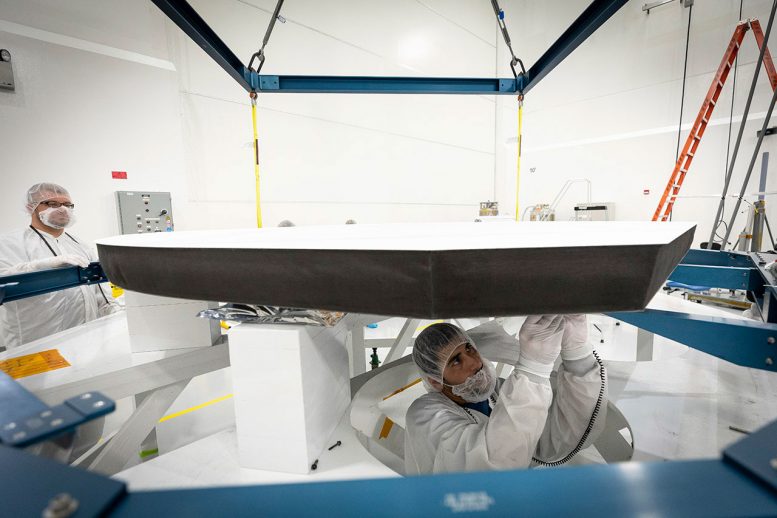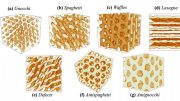
Illustration of Parker Solar Probe circling the Sun. Credit: NASA/JHUAPL
This summer, NASA’s Parker Solar Probe will launch to travel closer to the Sun, deeper into the solar atmosphere, than any mission before it. If Earth was at one end of a yard-stick and the Sun on the other, Parker Solar Probe will make it to within four inches of the solar surface.
Inside that part of the solar atmosphere, a region known as the corona, Parker Solar Probe will provide unprecedented observations of what drives the wide range of particles, energy and heat that course through the region — flinging particles outward into the solar system and far past Neptune.
Inside the corona, it’s also, of course, unimaginably hot. The spacecraft will travel through material with temperatures greater than a million degrees Fahrenheit while being bombarded with intense sunlight.
So, why won’t it melt?
Parker Solar Probe has been designed to withstand the extreme conditions and temperature fluctuations for the mission. The key lies in its custom heat shield and an autonomous system that helps protect the mission from the Sun’s intense light emission, but does allow the coronal material to “touch” the spacecraft.
NASA’s Parker Solar Probe is heading to the Sun. Why won’t the spacecraft melt? Thermal Protection System Engineer Betsy Congdon (Johns Hopkins APL) outlines why Parker can take the heat. Credit: NASA’s Goddard Space Flight Center
The Science Behind Why It Won’t Melt
One key to understanding what keeps the spacecraft and its instruments safe, is understanding the concept of heat versus temperature. Counterintuitively, high temperatures do not always translate to actually heating another object.
In space, the temperature can be thousands of degrees without providing significant heat to a given object or feeling hot. Why? Temperature measures how fast particles are moving, whereas heat measures the total amount of energy that they transfer. Particles may be moving fast (high temperature), but if there are very few of them, they won’t transfer much energy (low heat). Since space is mostly empty, there are very few particles that can transfer energy to the spacecraft.
The corona through which Parker Solar Probe flies, for example, has an extremely high temperature but very low density. Think of the difference between putting your hand in a hot oven versus putting it in a pot of boiling water (don’t try this at home!) — in the oven, your hand can withstand significantly hotter temperatures for longer than in the water where it has to interact with many more particles. Similarly, compared to the visible surface of the Sun, the corona is less dense, so the spacecraft interacts with fewer hot particles and doesn’t receive as much heat.
That means that while Parker Solar Probe will be traveling through a space with temperatures of several million degrees, the surface of the heat shield that faces the Sun will only get heated to about 2,500 degrees Fahrenheit (about 1,400 degrees Celsius).
The Shield That Protects It
Of course, thousands of degrees Fahrenheit is still fantastically hot. For comparison, lava from volcano eruptions can be anywhere between 1,300 and 2,200 F (700 and 1,200 C). And to withstand that heat, Parker Solar Probe makes use of a heat shield known as the Thermal Protection System, or TPS, which is 8 feet (2.4 meters) in diameter and 4.5 inches (about 115 mm) thick. Those few inches of protection mean that just on the other side of the shield, the spacecraft body will sit at a comfortable 85 F (30 C).
The TPS was designed by the Johns Hopkins Applied Physics Laboratory, and was built at Carbon-Carbon Advanced Technologies, using a carbon composite foam sandwiched between two carbon plates. This lightweight insulation will be accompanied by a finishing touch of white ceramic paint on the sun-facing plate, to reflect as much heat as possible. Tested to withstand up to 3,000 F (1,650 C), the TPS can handle any heat the Sun can send its way, keeping almost all instrumentation safe.
Betsy Congdon of Johns Hopkins Applied Physics Lab is the lead thermal engineer on the heat shield that NASA’s Parker Solar Probe will use to protect itself against the Sun. The shield is so robust, Congdon can use a blowtorch on one side and the other side remains cool enough to touch. Credit: NASA’s Goddard Space Flight Center
The Cup that Measures the Wind
But not all of the Solar Parker Probe instruments will be behind the TPS.
Poking out over the heat shield, the Solar Probe Cup is one of two instruments on Parker Solar Probe that will not be protected by the heat shield. This instrument is what’s known as a Faraday cup, a sensor designed to measure the ion and electron fluxes and flow angles from the solar wind. Due to the intensity of the solar atmosphere, unique technologies had to be engineered to make sure that not only can the instrument survive, but also the electronics aboard can send back accurate readings.
The cup itself is made from sheets of Titanium-Zirconium-Molybdenum, an alloy of molybdenum, with a melting point of about 4,260 F (2,349 C). The chips that produce an electric field for the Solar Probe Cup are made from tungsten, a metal with the highest known melting point of 6,192 F (3,422 C). Normally lasers are used to etch the gridlines in these chips — however due to the high melting point acid had to be used instead.
Another challenge came in the form of the electronic wiring — most cables would melt from exposure to heat radiation at such close proximity to the Sun. To solve this problem, the team grew sapphire crystal tubes to suspend the wiring, and made the wires from niobium.

Parker Solar Probe’s heat shield is made of two panels of superheated carbon-carbon composite sandwiching a lightweight 4.5-inch-thick carbon foam core. To reflect as much of the Sun’s energy away from the spacecraft as possible, the Sun-facing side of the heat shield is also sprayed with a specially formulated white coating. Credit: NASA/Johns Hopkins APL/Ed Whitman
To make sure the instrument was ready for the harsh environment, the researchers needed to mimic the Sun’s intense heat radiation in a lab. To create a test-worthy level of heat, the researchers used a particle accelerator and IMAX projectors — jury-rigged to increase their temperature. The projectors mimicked the heat of the Sun, while the particle accelerator exposed the cup to radiation to make sure the cup could measure the accelerated particles under the intense conditions. To be absolutely sure the Solar Probe Cup would withstand the harsh environment, the Odeillo Solar Furnace — which concentrates the heat of the Sun through 10,000 adjustable mirrors — was used to test the cup against the intense solar emission.
The Solar Probe Cup passed its tests with flying colors — indeed, it continued to perform better and give clearer results the longer it was exposed to the test environments. “We think the radiation removed any potential contamination,” Justin Kasper, principal investigator for the SWEAP instruments at the University of Michigan in Ann Arbor, said. “It basically cleaned itself.”
The Spacecraft That Keeps its Cool
Several other designs on the spacecraft keep Parker Solar Probe sheltered from the heat. Without protection, the solar panels — which use energy from the very star being studied to power the spacecraft — can overheat. At each approach to the Sun, the solar arrays retract behind the heat shield’s shadow, leaving only a small segment exposed to the Sun’s intense rays.
But that close to the Sun, even more protection is needed. The solar arrays have a surprisingly simple cooling system: a heated tank that keeps the coolant from freezing during launch, two radiators that will keep the coolant from freezing, aluminum fins to maximize the cooling surface, and pumps to circulate the coolant. The cooling system is powerful enough to cool an average sized living room, and will keep the solar arrays and instrumentation cool and functioning while in the heat of the Sun.
The coolant used for the system? About a gallon (3.7 liters) of deionized water. While plenty of chemical coolants exist, the range of temperatures the spacecraft will be exposed to varies between 50 F (10 C) and 257 F (125 C). Very few liquids can handle those ranges like water. To keep the water from boiling at the higher end of the temperatures, it will be pressurized so the boiling point is over 257 F (125 C).
Another issue with protecting any spacecraft is figuring out how to communicate with it. Parker Solar Probe will largely be alone on its journey. It takes light eight minutes to reach Earth — meaning if engineers had to control the spacecraft from Earth, by the time something went wrong it would be too late to correct it.
So, the spacecraft is designed to autonomously keep itself safe and on track to the Sun. Several sensors, about half the size of a cell phone, are attached to the body of the spacecraft along the edge of the shadow from the heat shield. If any of these sensors detect sunlight, they alert the central computer and the spacecraft can correct its position to keep the sensors, and the rest of the instruments, safely protected. This all has to happen without any human intervention, so the central computer software has been programmed and extensively tested to make sure all corrections can be made on the fly.
Launching Toward the Sun
After launch, Parker Solar Probe will detect the position of the Sun, align the thermal protection shield to face it and continue its journey for the next three months, embracing the heat of the Sun and protecting itself from the cold vacuum of space.
Over the course of seven years of planned mission duration, the spacecraft will make 24 orbits of our star. On each close approach to the Sun it will sample the solar wind, study the Sun’s corona, and provide unprecedentedly close up observations from around our star — and armed with its slew of innovative technologies, we know it will keep its cool the whole time.









I love Astrophysics